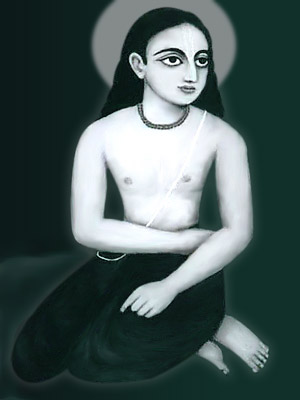 Nityananda is worshipped as an incarnation of Balarama. Nityananda was Chaitanya`s friend and disciple. They are also mentioned together as Gaura-Nitai or Nimai-Nitai Followers refer to Nityananda as `Sri Nityananda`, `Prabhu Nityananda` or `Nityananda Rama`.
Nityananda is worshipped as an incarnation of Balarama. Nityananda was Chaitanya`s friend and disciple. They are also mentioned together as Gaura-Nitai or Nimai-Nitai Followers refer to Nityananda as `Sri Nityananda`, `Prabhu Nityananda` or `Nityananda Rama`.
Nityananda is an incarnation of Balarama according to Gaudiya Vaishnavism and his eternal brother and friend is Chaitanya. He was born to a religious Bandyaghati Brahmin, Mukunda Pandit and Padmavati in Ekachakra in Birbhum district of present West Bengal around the year 1474. He was highly a devoted person and could sing Vaishnava hymns. He was known for his dramatic re-enactments of Lord Rama`s pastimes.
He left his home at the age of thirteen with a sannyasi known as Lakshmipati Tirtha. His father had offered the travelling sannyasi a gift anything he wished. Lakshmipati Tirtha replied to this that he was in need of someone to assist him in his travels to the holy places and Nityananda would be perfect. His father agreed to sannyasi`s wish as he had promised. This started his physical and spiritual journey through India which helps him to be in contact with important Vaishnava Gurus. He was also associated with Lakshmipati Tirtha`s famous other disciples like Madhavendra Puri, Advaita Acharya, and Ishvara Puri.
Jagai-Madhai is a well known tale related to Chaitanya and Nityananda. Once while chanting the name of Lord Krishna in the streets, Nityananda was attacked by Jagai and Madhai, two drunken brothers. Madhai threw an earthen pot which cut Nityananada`s forehead. Chaitanya heard about this and flew to a rage and wanted to kill the brothers with his Chakra. Nityananda requested him to pardon them. Thereafter they became disciples of Chaitanya.
He married two daughters of Suryadasa Sarakhela, Vasudha and Jahnava. He settled in Khardaha after marriage. He also had a son, Virachandra and a daughter, Ganga from his first wife Vasudha. His step mother later initiated Virabhadra to vaishnava rites.
This article is a stub. You can enrich by adding more information to it. Send your Write Up to content@indianetzone.com




















